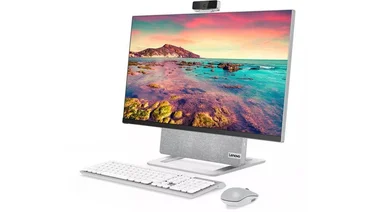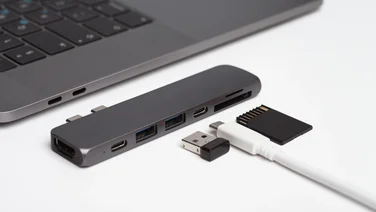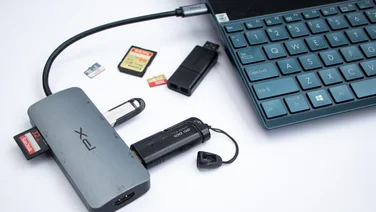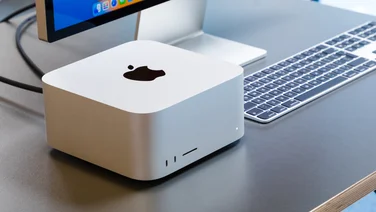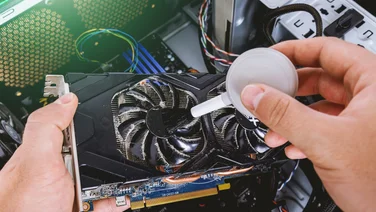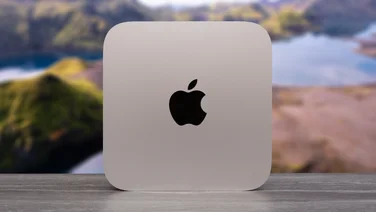To help us provide you with free impartial advice, we may earn a commission if you buy through links on our site. Learn more

HP has been showcasing its new desktop PC gamble, the HP Sprout, in a trendy corner of London’s Shoreditch this week. London’s East End is synonymous with up-and-coming creative types, so the HP Sprout immediately felt at home.
The innovative all-in-one PC has been on sale in North America since November of last year, and is finally reaching UK stores this month. HP describes the Sprout as an “immersive computing platform” and, after a thorough demonstration and some hands-on time, it seems like a particularly apt description.
The Sprout combines a familiar all-in-one desktop with a “Sprout Illuminator”, a projection and capture system that uses a soft, touch-sensitive mat placed directly in front of the Sprout’s screen. There’s a lot of technology packaged into the Illuminator, including a depth sensor, 14.6-megapixel camera, scanner and of course a projector that outputs a second display directly onto the mat. The Illuminator uses four cameras for its 3D scanning and Intel’s RealSense 3D camera technology.

The projector’s resolution is only 1,024×768, which is low in contrast to the 23in 1080p display of the touch-sensitive main screen. What makes the touch-sensitive mat a real joy to use is its 20-point capacitive multi-touch sensor, which let two people interact with every finger of each hand in a collaborative way. The sensitivity and resistance of the touch mat also felt great as we moved puzzle pieces around during one of the demos.
The projections have a 180 degree viewing angle and are able to reach 300nits at maximum brightness. We only saw the projection under dim lighting, but were told it should be bright enough without having to draw the curtains. The main 23in display is not height or angle adjustable, as the scanner is calibrated so specifically that reflections could potentially cause problems. We didn’t have any problems with the fixed angle and it felt comfortable to look at during our time with the system, but will need more thorough testing to confirm. There are the usual Ethernet, USB ports and memory card reader on the rear, as well as an HDMI output that could be useful for using the Sprout as a scanner/projector combination when hooked up to another display – potentially a great choice for a classroom environment.

The mat can be detached and is docked with a magnet that locks it satisfyingly into place. Windows 8.1 is able to detect when it has been removed. There are three capacitive navigation buttons at the base of the main display: one brings up a touch keyboard on the mat, the second takes you to a Home screen of your apps and the last can be used to turn off touch or the projector altogether. A standard wireless HP keyboard and mouse are also included with the system for a more traditional experience.
Brad Short who holds the title of Distinguished Technologist at HP as well as being the inventor of Sprout described the new system as a new beginning for the desktop system and not a final solution, potentially being the first of many new forms. Brad envisaged the Sprout making the desktop relevant again in the age of tablets and smartphones, “desktops were left out of innovation for a decade”.
We had a chance to use some of the dual-screen applications such as Virtual DJ, where the form factor immediately made more sense. While there are plenty of touch-optimised apps for Windows 8, these are designed with tablets in mind. As soon as you need to prod away at a vertical screen it breaks immersion and it’s a very different experience. The Sprout, instead, marries the two. The dual-screen experience immediately brings to mind very different platforms, the Nintendo 3DS, but expands on it not only in literal size and application but also in scope.
The real feather in the Sprout’s cap, however, is its 2D and 3D scanning capabilities. With a touch of a button the Sprout can scan an object placed on the mat and immediately bring up a virtual version for users to manipulate and share. It sounds like such a simple action but it’s handled elegantly and intuitively. The Sprout’s scanning software also had a few neat tricks such as background removal, creating an automated cutout of objects scanned.
They weren’t always 100% perfect but as a quick way of sharing or something you could tidy up further, it was a welcome tool. The scanner’s applications for digital scrapbooking or desktop publishing are obvious, but even the convenience of being able to scan an object within seconds opens up a world of opportunities for sharing scans quickly. With two Sprouts, it’s possible for users to collaborate over the internet. Both users can manipulate objects that are then replicated on the other user’s system and you can scan in and add objects or write notes using the included Adonit Jot Pro stylus.

Things get really interesting when you scan objects in 3D, however. The process takes less than a minute, during which time the Sprout’s camera emits a bright light to wash out any ambient light and fill in any shadows. The projector displays a grid of various patterns that the scanner uses for its depth perception using clever algorithms. We tested the Sprout using various objects and props including a costume mask and the results were impressive.
We immediately had a 3D model that could be rotated and the standard .obj file created could be imported into other applications for manipulation. The scan wasn’t perfect, however, with trickier nooks failing to be filled in from the initial scan. It is possible to stitch multiple scans together and we were shown an intricate 3D scan of a figurine that Brad said took about 45 minutes of work to piece together.

Pascal Bourquet, HP’s VP of Consumer Personal Systems, said that this is a process that HP is looking to streamline and shorten down to mere minutes. He mentioned the possibility of a future turntable to help automate the process. As it stands, an elegant and thorough 3D scan could require a lot of time, dedication and knowledge to complete. In testing, we found the scanner did best with items laid horizontally as anything above around eight inches became difficult for the scanner to detect.
The applications for 3D scanning open up various avenues, both in a consumer and commercial space. We were told the growing interest in 3D printing helped spur development of the Sprout and that’s certainly one area HP wants to leverage – the company sees the Sprout as a means for it to sell 3D printers in the commercial space.

The HP Sprout will only be available in a single configuration, retailing at £1,899. HP said this was in part to simplify the purchasing process and to ensure a single experience for everyone. The Sprout is equipped with an Intel Core i7-4790S processor, 8GB of RAM, 1TB of storage and Nvidia GeForce GT 745A graphics. It uses Windows 8.1 and takes advantage of its touch optimisation.
We were told the HP Sprout first became an idea five years ago and has been three years in development. It could be more years yet before it’s used to its full potential but we came away excited at a genuinely new path for desktop computing. It was refreshing to finally experience something new. It will be interesting to see how the Sprout gets used, and some of the work done by artists was certainly innovative.
^HP promotional video showcasing its work with artists
One artist crumpled paper which they then 3D scanned to create a mould. This was then used to shape wood to create unique desktop trays, as an example. The HP Sprout taps into people’s creativity and the ‘maker movement’, we could certainly see people using the Sprout to scan their handmade crafts for sale on Etsy and the like.

The Sprout’s potential will also rest on its adoption by software developers creating applications that take advantage of the dual-screens and scanning functionality. HP says it’s working with a number of big software houses and that these will be rolling out to the Sprout Marketplace in the future.
The HP Sprout will be available to pre-order from February 13th from HP’s online store, and will available from certain retailers including PC World, Harrods, Peter Jones, Dixons and John Lewis. Keep an eye out for an in-depth review as soon as they’re available.

